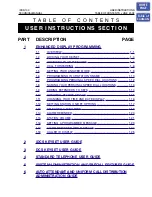
4
Installation
DIN EN 12056-4 states that all lifting units must be installed
such that they are buoyancy-proof and free-standing. At least
60 cm free working space must be provided around and above
the parts that require access for operation or maintenance.
The ventilation pipe must be vented above roof level, in com
-
pliance with DIN 12056. A wastewater sluice valve must be in
-
stalled on the inlet side, behind the non-return valve. A pump
sump must be provided, to facilitate the disposal of water from
the pump installation area.
ATTENTION!
All bolts that are used for fixing individual com
-
ponents to the tank should be tightened with a torque of no
more than 6 Nm.
Assembly
1.
Select the DN 100 inlet you wish to use and open this inlet
at the markings using a 102 Ø hole saw or a jigsaw. Then
deburr the edges.
2.
Fix the clamp flange (supplied with the unit) to the inlet with
the hexagon screws. Close the inlet valve to prevent water
from pouring out during assembly.
3.
Take the brackets that are used to fix the unit in place and
screw them to the tank. Then take the unit with the clamp
flange and push it onto the inlet pipe as far as it will go.
4.
Mark the positions of the wall plugs on the floor, then drill
the holes and push in the wall plugs.
5.
Now the clamp flange can be tightened and the unit can be
anchored to the floor using the wood screws and shims.
6. Connect the ventilation pipe to the slip-on socket pipe, DN
70.
7. Connect the shut-off valve (accessory) to the non-return val
-
ve.
8.
Screw the connecting flange onto the shut-off valve. Now
the pressure pipe can be connected to the flexible connec
-
tor.
Additional inlet, DN 50, vertical
This inlet can also be used to connect a diaphragm hand pump,
for the disposal of wastewater in emergency situations.
Using a hole saw, open the additional inlet by cutting along the
pre-cut groove. Deburr the edges.
Put the plug-in seal, 58/50, into place
Push the inlet pipe, with an external diameter of 50 mm, into
the tank through the plug-in seal. The distance from the bot
-
tom of the tank must be at least 30 mm.
Emergency disposal of wastewater
Fix the diaphragm hand pump to the wall in an easily accessible
position. Connect it to the pushed-in pipe and then connect
the pressure pipe to the diaphragm hand pump.
Additional inlet, DN 50, horizontal
Using a hole saw, open the additional inlet by cutting along the
pre-cut groove. Deburr the edges.
Put the plug-in seal, 58/50, into place.
Push the inlet pipe, with an external diameter of 50 mm, into
the tank through the plug-in seal. The distance from the bot
-
tom of the tank must be at least 30 mm.
ATTENTION!
The pipes that connect to the low-level inlets on
the side of the unit must be fitted with a bend, as close to the
unit as possible. The pipe invert of this bend must be at a height
of at least 180 mm above the floor on which the unit is fixed. Air
pockets in the connecting pipe can cause run-off problems and
the water could back-up. To prevent back-ups, the inlet pipe
must be vented at its highest point. The ventilation pipe can be
connected into the tank ventilation.
Install a shut-off valve in the additional inlet pipes used. Before
operating the diaphragm hand pump, close this valve. Other
-
wise, the odour trap of the bathroom fixture attached will be
sucked dry; the diaphragm hand pump will then draw in air
and stop pumping. Do not forget to open the valve again af
-
terwards.
Alarm system
If an acoustic signal would be inappropriate at the installation
site in question, an alarm signal can be relayed via the potenti
-
al-free contact. A mains-independent alarm (MN 20198) can be
installed as an accessory, if required.
Test run and functional check
(see also DIN EN 12056-4)
1. Test run
a. Open the maintenance cover of the tank.
b. Open the shut-off valves at the inlet and the pressure pipe.
c. Insert the mains plug into the socket.
d. Fill the tank up to the switch-on level.
e. The pump will now switch on and empty the container.
Observe the pumping process through the maintenance ope
-
ning. Then close the maintenance cover. Check to ensure that
the tank, fittings and pipes are watertight, by carrying out se
-
veral switching runs.
2. Check the alarm system
a. Lift the float of the level controller slowly by hand until it is
above the switch-on point and hold it there until the alarm is
triggered.
b. Close the maintenance opening again with the cover and
seal.
Summary of Contents for compli 300
Page 6: ...6 Example of installation...
























